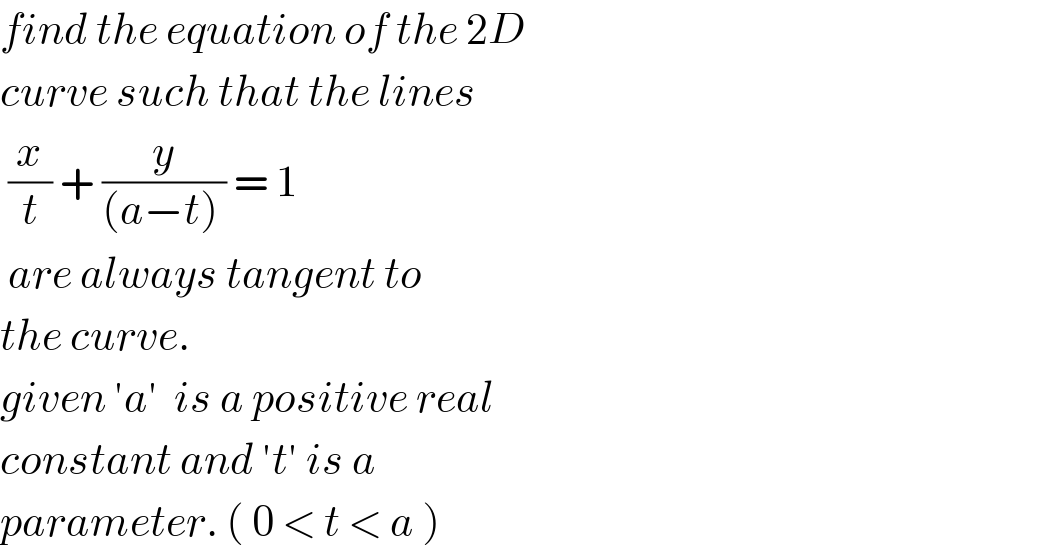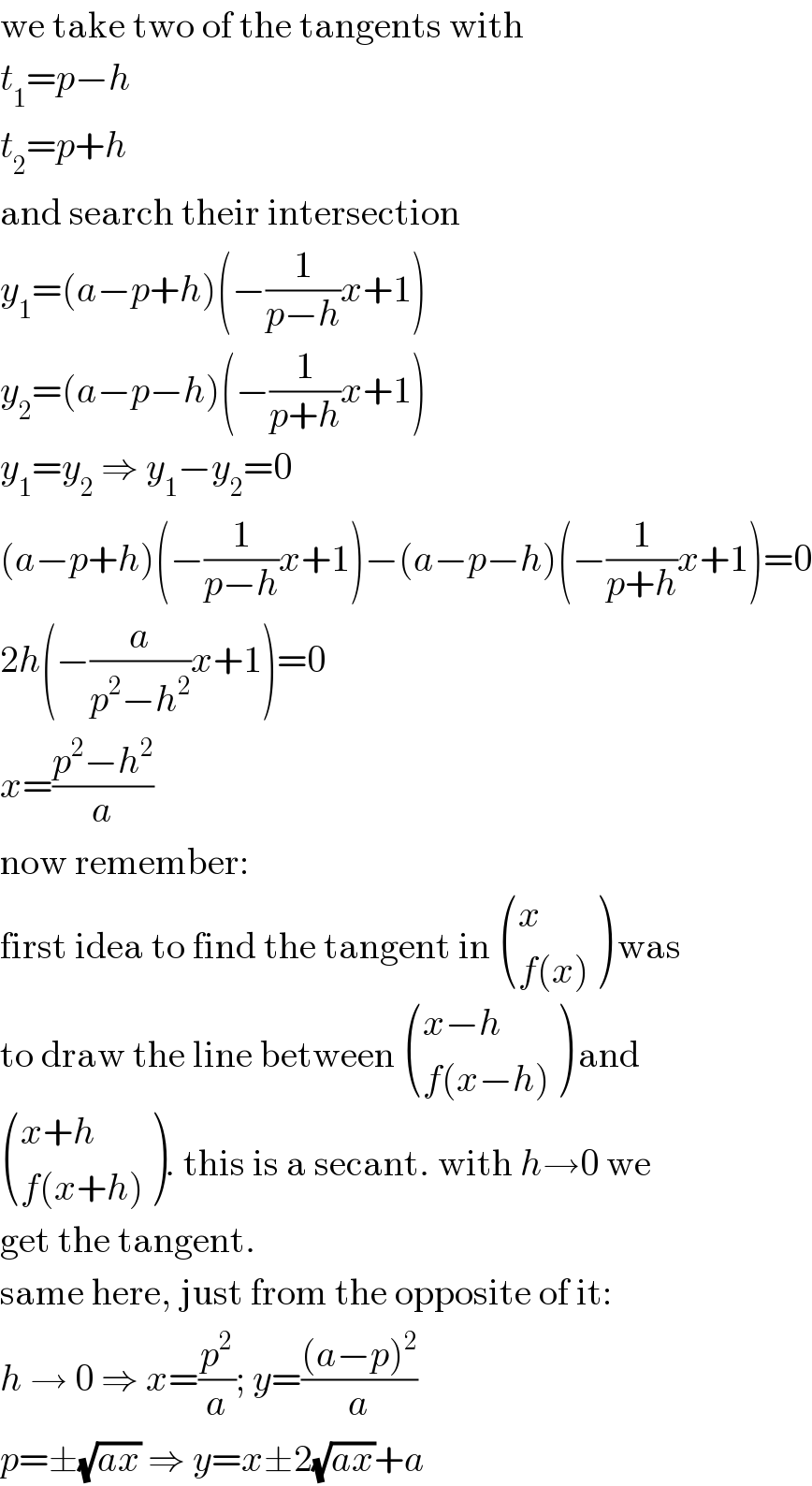
Question Number 34326 by 33 last updated on 04/May/18

$${find}\:{the}\:{equation}\:{of}\:{the}\:\mathrm{2}{D} \\ $$ $${curve}\:{such}\:{that}\:{the}\:{lines} \\ $$ $$\:\frac{{x}}{{t}}\:+\:\frac{{y}}{\left({a}−{t}\right)\:}\:=\:\mathrm{1} \\ $$ $$\:{are}\:{always}\:{tangent}\:{to} \\ $$ $${the}\:{curve}. \\ $$ $${given}\:'{a}'\:\:{is}\:{a}\:{positive}\:{real} \\ $$ $${constant}\:{and}\:'{t}'\:{is}\:{a} \\ $$ $${parameter}.\:\left(\:\mathrm{0}\:<\:{t}\:<\:{a}\:\right) \\ $$
Answered by MJS last updated on 05/May/18

$$\mathrm{we}\:\mathrm{take}\:\mathrm{two}\:\mathrm{of}\:\mathrm{the}\:\mathrm{tangents}\:\mathrm{with} \\ $$ $${t}_{\mathrm{1}} ={p}−{h} \\ $$ $${t}_{\mathrm{2}} ={p}+{h} \\ $$ $$\mathrm{and}\:\mathrm{search}\:\mathrm{their}\:\mathrm{intersection} \\ $$ $${y}_{\mathrm{1}} =\left({a}−{p}+{h}\right)\left(−\frac{\mathrm{1}}{{p}−{h}}{x}+\mathrm{1}\right) \\ $$ $${y}_{\mathrm{2}} =\left({a}−{p}−{h}\right)\left(−\frac{\mathrm{1}}{{p}+{h}}{x}+\mathrm{1}\right) \\ $$ $${y}_{\mathrm{1}} ={y}_{\mathrm{2}} \:\Rightarrow\:{y}_{\mathrm{1}} −{y}_{\mathrm{2}} =\mathrm{0} \\ $$ $$\left({a}−{p}+{h}\right)\left(−\frac{\mathrm{1}}{{p}−{h}}{x}+\mathrm{1}\right)−\left({a}−{p}−{h}\right)\left(−\frac{\mathrm{1}}{{p}+{h}}{x}+\mathrm{1}\right)=\mathrm{0} \\ $$ $$\mathrm{2}{h}\left(−\frac{{a}}{{p}^{\mathrm{2}} −{h}^{\mathrm{2}} }{x}+\mathrm{1}\right)=\mathrm{0} \\ $$ $${x}=\frac{{p}^{\mathrm{2}} −{h}^{\mathrm{2}} }{{a}} \\ $$ $$\mathrm{now}\:\mathrm{remember}: \\ $$ $$\mathrm{first}\:\mathrm{idea}\:\mathrm{to}\:\mathrm{find}\:\mathrm{the}\:\mathrm{tangent}\:\mathrm{in}\:\begin{pmatrix}{{x}}\\{{f}\left({x}\right)}\end{pmatrix}\:\mathrm{was} \\ $$ $$\mathrm{to}\:\mathrm{draw}\:\mathrm{the}\:\mathrm{line}\:\mathrm{between}\:\begin{pmatrix}{{x}−{h}}\\{{f}\left({x}−{h}\right)}\end{pmatrix}\:\mathrm{and} \\ $$ $$\begin{pmatrix}{{x}+{h}}\\{{f}\left({x}+{h}\right)}\end{pmatrix}.\:\mathrm{this}\:\mathrm{is}\:\mathrm{a}\:\mathrm{secant}.\:\mathrm{with}\:{h}\rightarrow\mathrm{0}\:\mathrm{we} \\ $$ $$\mathrm{get}\:\mathrm{the}\:\mathrm{tangent}. \\ $$ $$\mathrm{same}\:\mathrm{here},\:\mathrm{just}\:\mathrm{from}\:\mathrm{the}\:\mathrm{opposite}\:\mathrm{of}\:\mathrm{it}: \\ $$ $${h}\:\rightarrow\:\mathrm{0}\:\Rightarrow\:{x}=\frac{{p}^{\mathrm{2}} }{{a}};\:{y}=\frac{\left({a}−{p}\right)^{\mathrm{2}} }{{a}} \\ $$ $${p}=\pm\sqrt{{ax}}\:\Rightarrow\:{y}={x}\pm\mathrm{2}\sqrt{{ax}}+{a} \\ $$
